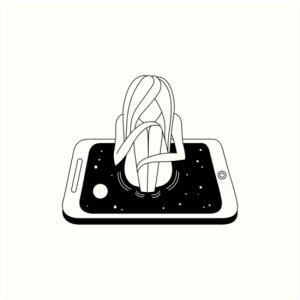I am alarmed by how I’m becoming increasingly addicted to my own smartphone. I’m devolving, HELP!
I picked up my phone 100 TIMES yesterday. For what? I’m an adult woman with a business, a family, great friendships and a bunch of fun projects I struggle to have time for already. So what’s with the increasing phone use?

This prospect terrifies me. I don’t want to be dumb. Or do I want to be driven by my phone – or more correctly – by a bunch of individuals in office towers who tell tech companies how to make me their slave.
I don’t like the values of these companies, I don’t like their ethos. Intuitively I know constant screen use is disconnecting us from one another, and yet my own use has been creeping steadily higher over the past few years. Why?
How do tech companies get us addicted to our smartphone devices?
Yesterday I read a great article in which Tristan Harris, an ex-Google employee, explained how tech companies are competing to find methods of keeping us hopelessly addicted to our smartphones (you can find the whole article here). It turns out they don’t care so much about our online experience as they do about how much time we spend on their platforms. The more time we spend, the more advertising dollars they can command from brands. In this way, free platforms such as Facebook, Instagram and Snapchat basically seek to distract us for long periods of time, during which they sell our attention to their advertisers. We have become the commodity.
Harris describes the competition between tech companies to get us addicted to their products as ‘a race to the bottom of the brainstem’. By whatever means possible, these companies are targeting our most primitive urges to get us hooked – including our need for connection, belonging and validation.
Interface design

Personal Data
Tech companies are using data collected in real time from us as we use our smartphone devices and in turn use it to predict how best to suck us into using our screens for even longer and longer periods of time. And we are smiling as we help them plot our demise! In a leaked document from 2017, Facebook told an advertiser that they could tell from data collected from an individual when that person felt ‘insecure’ and ‘worthless’.
Little Red Dots
Those pop-up notifications exist for the sole purpose of keeping us addicted. Not too long ago, programmers hypothesised they’d be able to get us looking more regularly if they notified us of information we haven’t seen yet. As part of their cunning plan, they decided to use the colour red, telling the primal part of our puny human brains ‘WARNING: YOU’D BETTER LOOK AT THIS NOW!’. The red badge icon was born. And gee, do those badges work! Notifications exist solely to inspire one of two emotions that keep us hooked: anxiety and FOMO.
Anxiety
The feeling that happens when I haven’t checked my phone for an hour. Don’t think this is a thing? Try taking a smartphone off a teenager before bedtime. If we are feeling anxious, it’s because of a cascade of neurotransmitters sloshing about in our brains, and research shows that those red dots precipitate the release of cortisol, a potent stress hormone. Red dots = BAD.
FOMO

.
Smartphone addiction is a thing
For us, receiving a notification on our smartphone can cause the release of dopamine, which is released in the brain when we receive a reward. Dopamine is also released when we have a hit of an addictive substance, such as nicotine, alcohol or cocaine. It stands to reason then, that if the platforms on our phones are responsible for all this dopamine release, we can quickly develop an ‘addiction’ to looking at them.
If you’re interested in a bit more science behind neurotransmitters and phone use, here’s an easy-to-decipher article for you: https://www.earth.com/news/smartphone-notifications-changing-brains/
We know prolonged screen use is damaging for our health and wellbeing – physically, socially and emotionally. On a physical level, we are seeing more sedentary behaviour, poorer posture, an increase in sleep difficulty, increased headaches and vision problems linked to increased use of technology. There is also research indicating our brain chemistry is being altered.
Socially, we are more connected than ever, but the type of connection we participate in matters. How much of our attention to the person in front of us are we committing? And how much is sneaky glances at our phone? You should try it sometime.
I find it simultaneously offensive and embarrassing that I know I’m being manipulated and I continue to play their game! I think the worst bit for me is finding out that they’re mining my own data to use against me. Ouch.
Lets put down our phones and reconnect

My conclusion from all of this? No more Facebook. I’m already not on Instagram (too lazy) or Snapchat (too old), and I fancy that I’ll be living a WAY more productive and connected life soon… once I get over the pain of quitting, of course.
Care to join me? We can do bushwalks, picnics, play music, and have face-to-face conversations and stuff!


